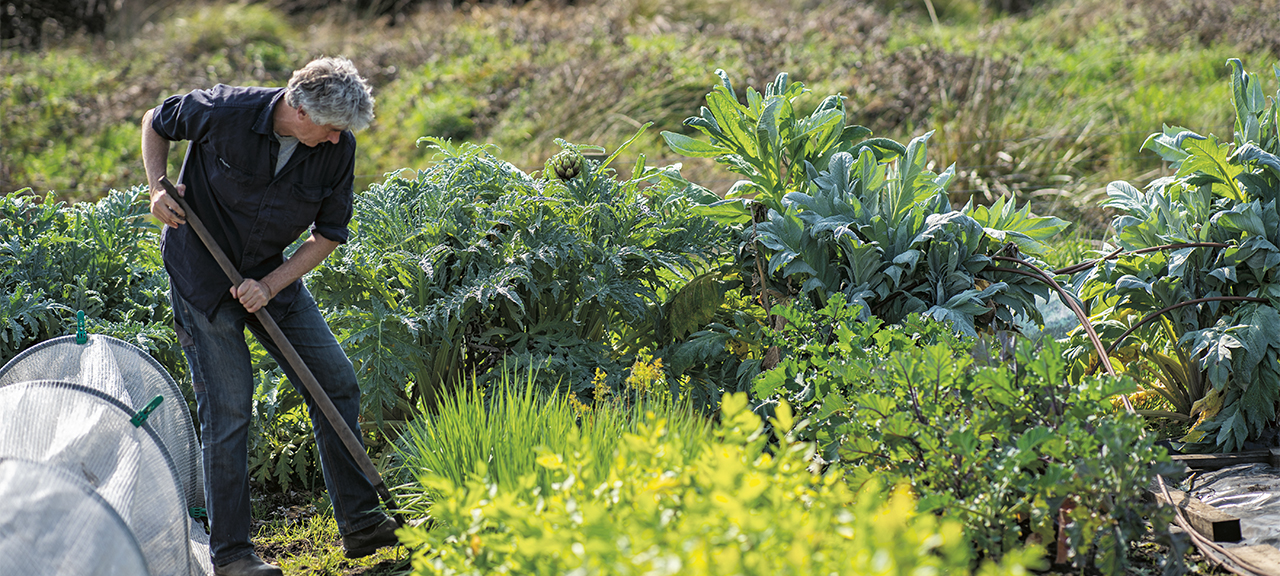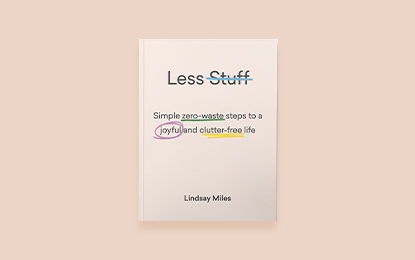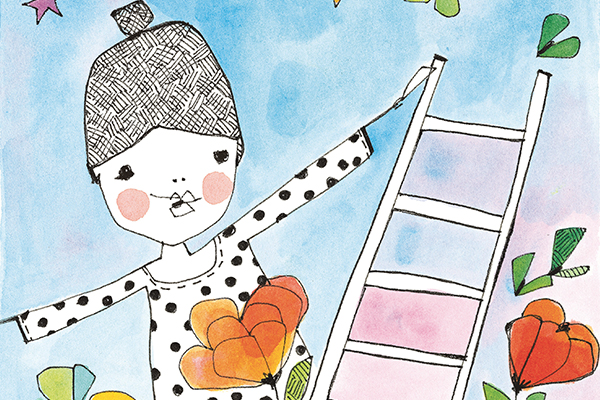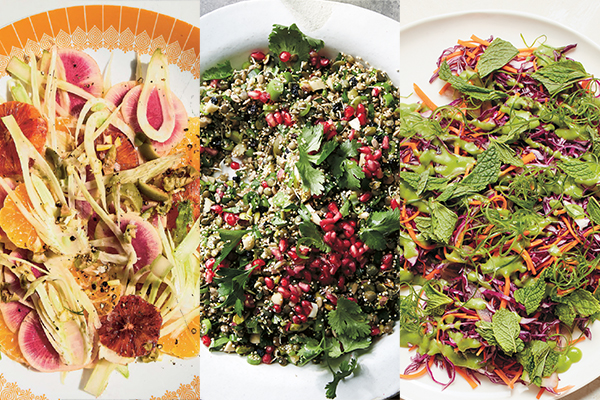Summer at Fat Pig Farm
29 Nov 2019 | Matthew Evans
We all want more air in our lives. Brighter skies, slower days, more time for growing, for cooking, for family. In The Commons, a book inspired by the hit SBS television show Gourmet Farmer, Matthew Evans captures Fat Pig Farm’s year of growing, cooking and feasting. In this extract from the book, Matthew’s diaries reveal in vivid detail the highs and lows of the farm during the summer months.
12 DECEMBER
Weather. I’m a weather bore. Here in Tassie, so are many others. It defines much of what people do. The forecast is all about sheep graziers, the size of the swells, the strength of coastal winds for fishermen, and occasional bushwalker alerts.
Farmers, by definition, are obsessed with the weather, by what happens in the skies. Because how Mother Nature treats us determines how we manage our land, rear our crops, grow food for you to eat. Farmers – alchemists who turn sunlight, soil and air into nourishment for the rest of the world – rely on what nature throws at them.
Right now, it’s throwing good things. Mild, with enough moisture in the soil for the grass, and there hasn’t been a frost for months. The garden is booming. Groaning, really. Zucchini have raced to the table. The strawberries have started in earnest. And the paddocks are long and lush, the perfect way for things to be before the big dry of the next few months, when grass stagnates. There’s a thick wodge of cream on the milk, thanks to a surfeit of clover. The long grass is a veritable playground for the pigs. Fruit is already fattening on the trees, small orbs drinking in the sunshine.
The rains, if this year follows the pattern, have gone for the next few months. The wettest time is winter, the driest when we need the rain the most. For the start of the dry, our dams are full, the grass long, our animals fat. We head into summer buoyed with possibility.
9 JANUARY
Hay’s in. The leggy grass, if cut at just the right time, stores its goodness for leaner months. If left to stagnate, it forms seeds, then returns to the atmosphere once again. If we can graze it, trample it to the ground, or turn it into hay, we’ve stashed carbon away for another day.
This is the first year we’ve pulled in hay without the threat of a storm. Strange, but true: in this driest of seasons usually the last decent rain of the summer is on the horizon as the hay baler rounds into the paddocks. Not this year, for the first time in the seven we’ve lugged hay. We enlist Rob, our new cook, on his second week, and Rowan, our farmhand, to help toss bales, stack bales, move bales, at the start of a long day on the farm. Five hundred bales later, the sheds are full. Money in the bank is how a farmer sees hay, once you’re over the itchy arms, the deep exhaustion from lifting bale after bale overhead and tossing them onto the ute. It’s a good tiredness. A virtuous fatigue, born of simple, hard labour.
We suck down water, litres of the stuff. We scoff fruitcake, Christmas leftovers, between loads. We have long since learnt to close our mouths and eyes when we move hay bales, to protect our sight and avoid choking on the stuff. I love the sweet smell of hay. I love the neatness of paddocks when the bales lie there catching the last of the sun’s rays. I love the muskiness of the hay shed. And I love the sleep that comes from an honest day’s work on the farm.
22 JANUARY
The heat brings new harvests. Our eggplants are sublime. Dark, purple, stained with stripes, fat and thin varieties, some shaped like a rotund clown, some long and curved back like a gymnast.
The zucchini give and give and give. We stuff their fresh flowers with house-made ricotta enriched with cream and scented with herbs. We roast tomatillos until they’re dark, blacken onions and bake whole bulbs of garlic to flavour them with. Add some dried oregano and paprika and you’ve got a salsa.
Cucumber flowers, precious as pearls to us, make a singular visit to the table: a fleeting appearance one lunch of the year, their elegant flavour as much about captured sunshine as it is about cucumber.
In our hearts we know summer will look like this, with parched soil and dry grass. But it still surprises each year. As we tick off more and more years on the land, the seasons continue to creep up on us. In summer we can’t quite believe that, come winter, the paddocks will become boggy and the driveway turn into a creek. But equally, in the emerald green of spring, summers past seem calmer, less arid, more lush in hindsight than they were at the time. That’s what we love about this place. One of the many things, anyway: the endlessness of seasonal change. The astonishment and wonderment at the passing of time as the light changes and the earth moves and the plants and birds and wildlife tell us that, yes, it is summer once more and it is a time of low rain and higher temperatures. It is a time of bounty that has to be preserved for leaner months.
Peaches fall from the tree. The first apples, the early season Vista Bella and Gravenstein and Beauty of Bath are all so ripe they start to drop faster than we can pick them. These windfalls are fed to pigs, some to the cattle as a sweet treat. The peaches, well, if we get to them the same day, these are peaches as nature intended them to be. As sweet and fragrant as is possible, because that gives the seed deep within the melting flesh the best chance at germinating. And this flesh is the peach of our dreams. The sort you eat over the bathtub. The kind you giggle at while you eat. They’re so good that Nadia, our gardener, rates this time of year the best of all to be making clandestine trips to the food forest. The best time of year to be in the garden generally, despite her access to all the other seasons’ incredible produce. The peaches are the moment magic really happens. But it only happens for about a fortnight at most.
24 JANUARY
Dry. Bone dry. Earth-crackingly dry. For us, this is unusual. We’ve just come through the driest January in forever. In this particular corner of southern Tasmania, the southernmost shire in the country, dry spells aren’t like those where I grew up. My childhood was spent in the sun-kissed mainland Australian interior. Canberra and surrounds aren’t blessed with rainfall. Or topsoil. Canberra has a harsher summer, a more punishing winter than Cygnet. But the grasshoppers, the sticky little black flies, the golden-coloured grass that arrive with late summer in Tassie, they’re all reminiscent of the hills of my youth. Not that I’m looking at hills.
I skewered my finger this morning. Fifteen millimetres
(more than half an inch) of timber has left the firewood I was splitting and inserted itself in the flesh of my hand. It sits, threaded, in the side of my pointer finger, just before the third joint. Half is visible, and the other half lies embedded in my flesh. When I say ‘threaded’, I’m not kidding. On either end of where this mini wood chip lies, concealed underneath my skin, is visible a few millimetres of wood. I need tweezers. And fast. The pain is excruciating. It’s a sign of how weak we humans are, and how weak I am as an individual in particular, that a small fragment of wood can have me incapable of rational thought. My mind is emblazoned with pain. It’s all I can do to control my body and stay upright. It’s important to pull a splinter like this out, but in which direction? The way the sliver of wood went in, wagering that it is bigger at the top than the bottom? Or the way it was going, so as not to risk a smaller shard of wood shearing off the side of the woodchip and heading off deeper into my flesh?
That, I must say, is all I can think of. Not soil health. Not the yellowing hills and the need for green grass for our dairy cows. Not the need to curb my swearing. I am obsessed with the splinter. And tweezers. WHERE ARE THOSE TWEEZERS?
28 JANUARY
We sit beneath the smoke. Under a Watch and Act alert, the second highest bushfire warning on the Tasmanian Fire Service website. Just under the Emergency warning. It’s the seventh day of smoke. We feel the smoke stinging our eyes, rasping our throats. We watch as charred ferns and bark and leaves rain down from the smudged out sky. Rarely, we see the sun, red behind the billowing smoke.
And yet, this isn’t really our fire. At present it threatens those close to us personally, but a few kilometres removed in reality. Friends with dairy cows, pigs, homes, lives, all hanging in the balance. Day after day, the alerts alter. The radio is alive with news, so much news it becomes as suffocating as the air, but it's news we must have, that we devour, that we obsess over.
Our days are filled with preparations to leave. A bag perpetually packed. Feed for the livestock planned. Decks and grass and the timber cladding of the house soaked. Wallows overflowing. Dams opened to cattle. And always water, water, water, in the paddocks, on the house, pumping it, moving it, spraying it.
In the distance, fire crews, exhausted probably after a month of trying to extinguish blazes – both man-made and from 3000 dry lightning strikes – work incessantly. We see them driving up our road. Patrolling. We see the trucks parked, looking over the Huon River, to where Geeveston and Castle Forbes Bay and Franklin are threatened by a fire so wild that they have to wait for it to appear out of the thick black smoke. We know that they have made so many safe, but that the fires rage in many parts of the state. Dozens of blazes, some destroying ancient Gondwanan forest, others creeping close to rural communities. Tasmania, this year, is gasping for air.
We know that in times like this, we can rely on the fighters of fire. We can rely on our community. We know that this will pass. But we also know that despite living in a rural idyll, fire is a real and present danger. One we hope beyond hope doesn’t damage us, our friends, our neighbours, our community, or our incredible natural heritage.
As we watch and wait, life goes on. We must keep those around us, our companions, our children, free from unnecessary worry. We still water the garden, plan harvests, work on menus, even though we have been up every hour during the night to check the horizon and the updates. This is just another thing that life throws at you, not something that defines you. Even now, with uncertainty hanging like the russet haze in the air, we know our lives are more secure than those of so many in the world. So much more certain than many of the vulnerable in our society.
Others bear a far heavier burden in terms of fighting fires and preparing their farms, and being evacuated from their homes. These days will pass soon, though not soon enough.
7 FEBRUARY
The rain falls, building from a few drops to a heavy downpour, like a symphony rising, rising, rising in volume. I feel the rain as though it is dousing my soul, a soothing, drenching, overwhelming force that gives life to the paddocks and death to the fires that have raged over the hill. With it comes relief. The relief of a tragedy averted, a challenge avoided, a threat assuaged.
Summer has burned this year, not just in Tassie’s wild places. It has been the hottest anyone has known in these parts, breaking all-time records for days over 30C, dry days, days over 25C. Records have tumbled often since we arrived, perhaps because records themselves are a relatively recent import in these climes. Or perhaps records tumble because we haven’t had this much carbon dioxide in the atmosphere for a few hundred thousand years. The paddocks have burned off under the baking sun to golden sheaves. Some adolescent trees look parched – even the natives, but more so the imports such as oak and elder. The heat showed perhaps we were unprepared, but this heat, well, it was unexpected.
Weather. It means everything to us, as I’ve said before. More so at this point in time, when the weather has been kind to us, blowing gently from the east as I write, with more rain, heavy rain, forecast.
The threat to humans and our habitat from bushfires is low and retreating by the day. We are grateful that we, and the people we share our gorgeous valley with, have emerged a little worn but generally unscathed. Healing begins. Blue skies, gentle breezes and low fire risk mean we can draw breath, deep, deep breath, especially when the smoke has almost vanished from our little corner of the state.
Other locals are still unsettled, unnerved, some unhoused. We think of them as we start to live life again as normal. We’re glad to get back to the routines, to the humble arts of growing and cooking food in a pretty damn special part of the world.
“Our summer harvest is full of things we preserve for other times – passata, cucumber, pickles, polenta corn and more.”

We’ve reached peak zucchini. The garden is bountiful, almost too bountiful, particularly with a few bits and pieces at this time of year, zucchini highest among them. We sliver them finely and put them in salad. We cook them long and hard and make a relish, we ferment them. We chargrill them to serve with fresh pesto. And still there’s more than enough for our needs.
I contemplate giving visitors to the farm a few zucchini as a parting gift. These amazing, flavour-packed signs of summer are one that we can’t really keep up with in the kitchen. But, as the others on the farm point out, giving someone zucchini, at this time of year, has the potential to be considered an insult.
The heat brings new harvests. Our eggplants are sublime. Dark, purple, stained with stripes, fat and thin varieties, some shaped like a rotund clown, some long and curved back like a gymnast.
The zucchini give and give and give. We stuff their fresh flowers with house-made ricotta enriched with cream and scented with herbs. We roast tomatillos until they’re dark, blacken onions and bake whole bulbs of garlic to flavour them with. Add some dried oregano and paprika and you’ve got a salsa.
Cucumber flowers, precious as pearls to us, make a singular visit to the table: a fleeting appearance one lunch of the year, their elegant flavour as much about captured sunshine as it is about cucumber.
In our hearts we know summer will look like this, with parched soil and dry grass. But it still surprises each year. As we tick off more and more years on the land, the seasons continue to creep up on us. In summer we can’t quite believe that, come winter, the paddocks will become boggy and the driveway turn into a creek. But equally, in the emerald green of spring, summers past seem calmer, less arid, more lush in hindsight than they were at the time. That’s what we love about this place. One of the many things, anyway: the endlessness of seasonal change. The astonishment and wonderment at the passing of time as the light changes and the earth moves and the plants and birds and wildlife tell us that, yes, it is summer once more and it is a time of low rain and higher temperatures. It is a time of bounty that has to be preserved for leaner months.
Peaches fall from the tree. The first apples, the early season Vista Bella and Gravenstein and Beauty of Bath are all so ripe they start to drop faster than we can pick them. These windfalls are fed to pigs, some to the cattle as a sweet treat. The peaches, well, if we get to them the same day, these are peaches as nature intended them to be. As sweet and fragrant as is possible, because that gives the seed deep within the melting flesh the best chance at germinating. And this flesh is the peach of our dreams. The sort you eat over the bathtub. The kind you giggle at while you eat. They’re so good that Nadia, our gardener, rates this time of year the best of all to be making clandestine trips to the food forest. The best time of year to be in the garden generally, despite her access to all the other seasons’ incredible produce. The peaches are the moment magic really happens. But it only happens for about a fortnight at most.
All text extracted from The Commons: A Year of Growing, Cooking and Eating on Fat Pig Farm by Matthew Evans Available now in bookstores and online Click here to find your preferred online retailer






